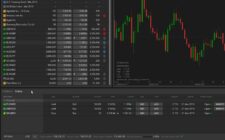In an automated trading system known as an “algo,” automated, programmed trading instructions are used to generate lightning-fast, unbiased trading judgments. Due to the quicker analysis and execution of deals, it allows for better prices.
Algo traders don’t have to spend as much time keeping an eye on the markets as non-algo traders do since algorithms are immune to fear and greed. The most important benefit of algorithmic trading is the ability to backtest its rules to evaluate their efficacy, which makes it simpler for an algorithmic trader to remain patient and disciplined. In algo trading, trades are carried out following certain pre-programmed directives from the trader known as algo trading strategies.
What is Algorithmic Trading?
Algorithmic trading, also known as automated trading or algo trading, refers to using computer programs to execute financial market trading strategies. It involves developing and implementing trading algorithms that analyze vast amounts of market data, identify patterns, and make trading decisions based on predefined rules and parameters. This trading method has gained significant popularity recently, offering several advantages over traditional manual trading approaches. In the following sections, we will explore some common algorithmic trading strategies and their benefits to traders and investors.
Strategies
Momentum Trading: Momentum trading is a strategy that relies on the idea that stocks that have recently shown an upward or downward trend will continue in that direction for a certain time. Algorithmic strategies analyze historical price data and technical indicators to identify these trends. The algorithm will then automatically execute trades to take advantage of the trend. This approach aims to profit from short-term price movements and is especially helpful in volatile markets.
Mean Reversion: The mean reversion strategy is founded on the idea that asset prices tend to return to their average or mean price over time. With the help of algorithms, instances where a price deviates significantly from its historical average, can be identified, presenting a potential opportunity for profit. The algorithm then executes trades to take advantage of the expected price correction. This strategy is typically employed in range-bound markets, where prices fluctuate within specific levels.
Arbitrage: Arbitrage is a way to make money by taking advantage of price differences between markets or related assets. Algorithmic trading uses advanced algorithms and fast connections to identify and take advantage of these opportunities quickly. This strategy relies on finding temporary imbalances in supply and demand or pricing inefficiencies, which only exist for a short time and can create small price differences.
Statistical Arbitrage: Statistical arbitrage is a trading strategy capitalizing on pricing inconsistencies in related securities. The algorithm analyzes these securities’ historical patterns and relationships and executes trades based on statistical models. For instance, if two stocks usually move in sync but have temporarily diverged, the algorithm will purchase the underperforming stock while selling the outperforming one, expecting the prices to converge once again eventually.
Scalping: High-frequency trading tactics like scalping aim to capitalize on minute price changes. Algorithms monitor the order book and execute trades within milliseconds to capture small price differentials. This strategy relies on high-speed connectivity and low-latency trading systems to capitalize on short-lived opportunities. Scalping strategies often involve high trading volumes and require robust risk management techniques.
Benefits of Algorithmic Trading Strategies:
- Speed and Efficiency: Algorithms can execute trades much faster than human traders, enabling instant reaction to market conditions and reducing the risk of missed opportunities.
- Reduced Emotion and Bias: Algorithmic trading removes human emotions and biases from decision-making, leading to more disciplined and objective trading strategies.
- Backtesting and Optimization: The performance of algorithms may be evaluated, and parameters can be optimized by backtesting them using past data. This allows traders to fine-tune strategies and increase their chances of success.
- Increased Market Liquidity: Algorithmic trading adds liquidity to the market by providing continuous buy and sell orders, contributing to smoother price movements and tighter bid-ask spreads.
- Risk Management: Algorithmic strategies can incorporate risk management techniques like stop-loss orders to limit potential losses and protect capital.
Conclusion
Overall, algorithmic trading strategies offer numerous advantages for traders and investors, allowing them to benefit from faster and more efficient trade execution and the potential to capitalize on market inefficiencies. Utilizing a reliable and advanced algo trading platform is crucial to harness these benefits effectively. Platforms like ShareIndia provide sophisticated tools and technologies that empower traders to implement and optimize their algorithmic trading strategies while ensuring robust risk management and regulatory compliance. Choose a trusted algo trading platform like ShareIndia to enhance your trading capabilities and stay ahead in today’s dynamic financial markets.




